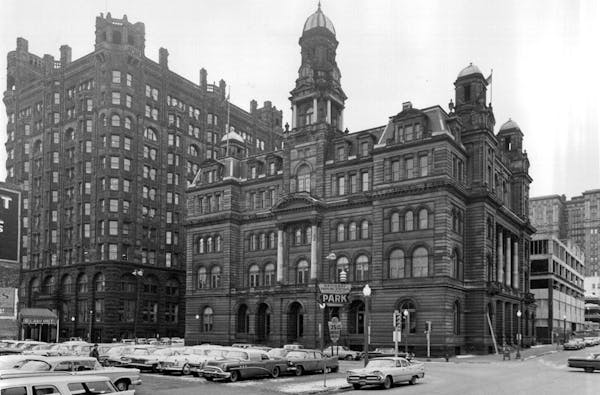A new shiny Public Service Building is rising in Minneapolis on 4th Avenue S. across from City Hall.
That means curtains for the old building with a similar name, the Public Service Center, at 250 S. 4th St.
Reaction to the news that the old Public Service Center will be razed seem to fall into one of two categories:
1. What building?
2. Oh, that one. So what?
The Public Service Center is not a landmark. A standard-issue, late 1950s office building, it's notable only for its light turquoise colored glass, which evokes an old Formica counter.
The building is modest: five stories tall. And its entrance, which consists of nesting squares, makes the building seem squat. The lobby boasts sheets of marble in a light hue favored by '50s designers.
To us, the glass-and-metal building seems common, mediocre, even. A lot of buildings that looked a lot like it were built in the '50s and '60s. It's not like it's special.
But it was when it opened in 1957 as the Public Health Center. Back then, boxy glass-and-metal boxes represented the future — a simple, efficient structure with recessed lighting, modern furniture and big IBM computers whirring away in the basement.
In a 1957 story on the building and its role, the Minneapolis Star called it "the guardian of the community welfare — a guardian who takes nothing for granted."
The Public Health Center was designed by Thorshov & Cerny, an architecture firm that designed many postwar buildings in the Twin Cities, including Metropolitan Stadium in Bloomington and Rapson Hall on the University of Minnesota campus. At its worst, it designed dull buildings like the Hennepin County Family Justice Center, an unredeemable mediocrity.
The Public Health Center might have been their best work.
It's understandable if you don't like it. Few buildings are universally admired. You may not like modern glass-and-metal architecture. And it's true that the Public Health Center has no romance, no abstraction, no mysteries.
But dull isn't always bad.
Downtown has some office buildings from a hundred years ago that were dull by design. Consider the old Security Bank Building, now the Emery Hotel. Its facade is as fascinating as a blank piece of paper. Then there's the 10-story Western Union Bank Building at 317 2nd Av. S. Now undergoing a transformation into a Hilton hotel, it has almost no ornamentation aside from a few drab patterns near the top.
But if these less-than-ornamental buildings went away we would miss them, in part because they bring variety and history to the cityscape.
Downtowns are defined by the collections of buildings, not one iconic tower. You need the grave sobriety of a '50s building and the tower sheathed with mirrored glass. The rough stone and the sleek steel. You do not necessarily want them cheek-to-jowl.
In a perfect city, the old and new would coexist with mutual acknowledgment and respect. But it's enough these days to hope the old simply exists at all.
It might be jarring to the baby boomer generation to realize that the Public Service Center's style is old. It was meant to be modern forever, but its attempt to stand outside of time is precisely what dates it.
Will it be mourned? No. But it will be missed.








